Kontaktaufnahme
Live-Chat mit Tektronix-Vertretern. Verfügbar von 9 bis 17 Uhr CET Geschäftstage.
Kontaktieren Sie uns telefonisch unter
Verfügbar von 9 bis 17 Uhr CET Geschäftstage.
Download
Laden Sie Handbücher, Datenblätter, Software und vieles mehr herunter:
Feedback
Arbitrary Waveform Generators
AWG70000B Series Datasheet
Weitere Informationen
- Arbiträrsignalgenerator AWG70000B
- Produkt-Support
- Weitere Arbiträrsignalgeneratoren Modelle entdecken
Online lesen:

The AWG70000B Series arbitrary waveform generators (AWG) represent the cutting edge for sample rate, signal fidelity, and waveform memory, making them ideal for design, testing, and operations of complex components, systems and experiments. With up to 50 GS/s and 10-bit vertical resolution, it delivers the industry's best signal stimulus solution for easy generation of ideal, distorted, and "real-life" signals.
Key performance specifications
- Sample rates up to 50 GS/s
- -80 dBc spurious free dynamic range
- 10 bits vertical resolution
- Waveform memory of up to 32 GSamples
Key features
- Complete solution for wideband RF signal generation in a single box
- Direct generation of wideband signals with carriers up to 20 GHz, removing the need for external RF conversion
- Simulate real-world analog effects on high speed digital data streams
- Model signal impairments up to speeds of 12.5 GB/s
- Generate high precision RF signals
- Spurious Free Dynamic Range performance better than -80 dBc
- Create high speed baseband signals for optical transmission with the vertical resolution to handle higher order complex modulation
- 10 bits of vertical resolution at a sample rate of 50 GS/s
- Create long waveforms scenarios without building complex sequences
- Up to 32 GSamples of Waveform Memory plays 640 ms of data at 50 GS/s
- Synchronize multiple units (manually or with the AWG Synchronization Hub) to achieve a multi-channel high speed AWG system
- Fully operational without external PC
- Built-in display and buttons make it possible to quickly select, edit and play waveforms directly from the front panel of the AWG
- Simulate real-world environments by playing back captured signals
- Waveforms captured with Oscilloscopes or Real-Time Spectrum Analyzers can be played back, edited, or re-sampled on the AWG
- Smooth transition from simulation to the real-world testing environment
- Waveform vectors imported from third-party tools such as MATLAB
- Sequencer with Streaming ID
- Control the Sequencer directly via a network interface connection
Applications
- Wideband RF/MW for communications and defense electronics
- Output wideband RF signals up to 20 GHz
- Validation and compliance testing of high speed silicon and communications devices
- Easily stress test receivers with a wide array of signal impairments
- Coherent optical research
- Generation of high Baud rate baseband signals with higher order, complex modulation
- Leading edge research in electronics, physics & chemistry
- High speed, low jitter signal source generates uniquely specified analog signals, fast pulses, data streams and clocks
Performance you can count on
Depend on Tektronix to provide you with performance you can count on. In addition to industry-leading service and support, this product comes backed by a standard one-year warranty.
Seamless transition from simulation to generation
If a waveform can be defined or captured, then the AWG70000B can generate the signal. The creation of the waveform can happen in many ways. Waveform creation plug-ins, which are optimized to work specifically with the Tektronix AWG family, provide specific waveform creation capabilities, while 3rd party solutions like MATLAB, Excel, or others, have the flexibility to create any waveform you desire. Waveforms created in any of these packages can be imported and played back in the AWG70000B, seamlessly transitioning from the simulation world to the real world.
Additionally, any signals captured on Tektronix oscilloscopes or Real-Time Spectrum analyzers can be loaded into the AWG70000B and played back. With the use of the built in waveform generation plug-ins, the captured signal can also be modified or changed to meet any specific requirements that may exist.
Wideband RF signal generation
RF signals are becoming more and more complex, making it more difficult to accurately create the signals required for the testing and characterization of RF systems. To address these challenges, RF Generic delivers advanced capabilities to synthesize digitally modulated baseband, IF and RF/microwave signals supporting a wide range of modulation schemes.
The RF Generic, Radar, Multitone, OFDM, and Environment plug-in's easy to use graphical user interfaces integrate seamlessly with the AWG70000B Series user interface or the SourceXpress remote PC application.
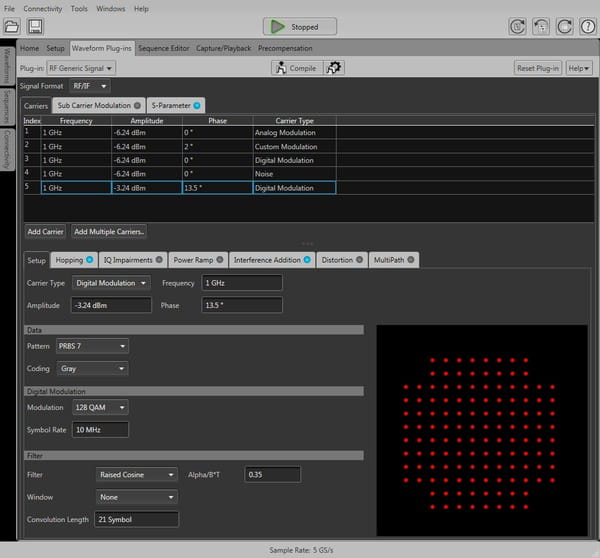
The latest digital RF technologies often exceed the capabilities of other test instruments because of the need to generate the wide-bandwidth and fast-changing signals that are increasingly seen in many RF applications such as Radar, RF communications, OFDM, and Multi-tone. When used in conjunction with the specific plugin, the AWG70000B Series supports a wide range of modulation formats and simplifies the task of creating complex RF waveforms. The AWG70000B Series instruments provide customers with ways to generate fully modulated baseband, intermediate frequency (IF) signals, or directly generated RF waveforms up to 20 GHz.
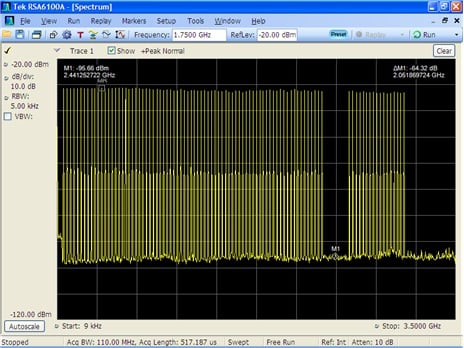
Radar signal creation
Generating advanced radar signals often demands exceptional performance from an AWG in terms of sample rate, dynamic range, and memory. The Tektronix AWG70000B Series sets a new industry standard for advanced radar signal generation, by delivering wide modulation bandwidths up to 20 GHz. With a sample rate of up to 50 GS/s, the AWG70000B Series can directly generate RF signals never before possible from an AWG. In instances where IQ generation is desired, the AWG70000B offers the ability to oversample the signal, thereby improving signal quality with its outstanding SFDR performance.
The AWG70000B and the Radar plug-in are the perfect solution for creating complex radar signals. Users get the ultimate flexibility in creating custom radar pulse suites. Modulation types such as LFM, Barker and Polyphase Codes, Step FM, and Nonlinear FM are easily created using the AWG, and the flexibility of the plug-in enables the creation of waveforms requiring customer-defined modulation. The combination AWG and Radar plug-in solution also has the ability to generate pulse trains with staggered PRI to resolve range and doppler ambiguity, frequency hopping for Electronic Counter-Counter Measures (ECCM), and pulse-to-pulse amplitude variation to simulate Swerling target models including antenna scan patterns, clutter, and multipath effects.
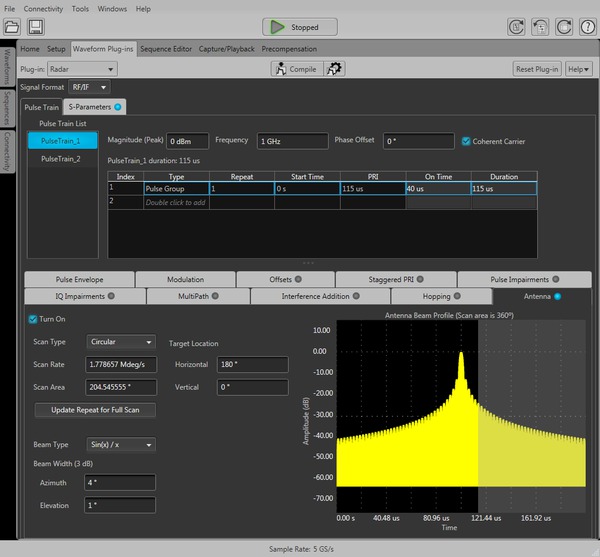
Environment signal generation
The mission-critical nature of many radar signals requires that they coexist with standards-based commercial signals sharing the same spectrum without performance degradation. To meet this expectation, a radar designer has to thoroughly test all the corner cases at the design/debug stage. The AWG70000B and the Environment plug-in offers extreme flexibility to define and create these worst-case scenarios.
You can specify up to 50 scenarios to define your environment, including WiMAX, WiFi, GSM, CDMA, W-CDMA, DVB-T, Noise, Bluetooth, LTE, OFDM, Radar and more. This plug-in also allows you to seamlessly import signals from other plug-ins (including Radar, RF Generic etc.), as well as from Matlab® and from Tektronix spectrum analyzers and oscilloscopes, into your environment. You can also configure PHY parameters of your standard-specific signals. You can define the carrier frequency, power, start time, and duration for all the signals in your environment, so you have full control over the way these signals interact/interfere with each other.
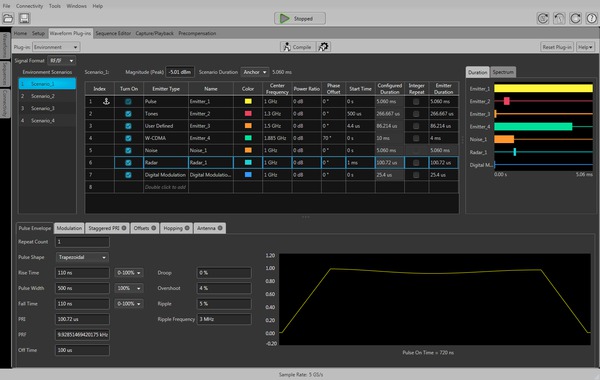
Coherent optical
Today's high speed and increasingly web driven world is pushing the demand for short and long haul coherent optical development. Phase modulation, high baud rate, high sample rate, bandwidth and resolution are all critical to optical applications. Tektronix understands the challenges and inconsistencies of coherent optical testing and offers a reliable, easy to set up and high performing tool set for optical testing, waveform generation and calibration.
The Tektronix AWG70000B Series Arbitrary Waveform Generator (AWG) can reach sampling rates as high as 50 GS/s with 10 bits vertical resolution. Such level of performance allows for the direct generation of IQ basebands signals required by modern coherent optical communication systems based on quadrature modulation of an optical carrier with data rates well over 200Gb/s. Multiple AWG70000Bs can be synchronized (manually or with the AWG Synchronization Hub) to use the max 50 GS/s on each baseband signal with low EVM and 32 Gbaud performance.
Generating the desired signal is only the first challenge in coherent optical. The quality of the signal, low EVM's and having a clear open eye is crucial. The Optical plug-in, in conjunction with the pre-compensation plug-in, can be used for calibration of the AWG to the device under test and for precompensation of coherent optical signals.
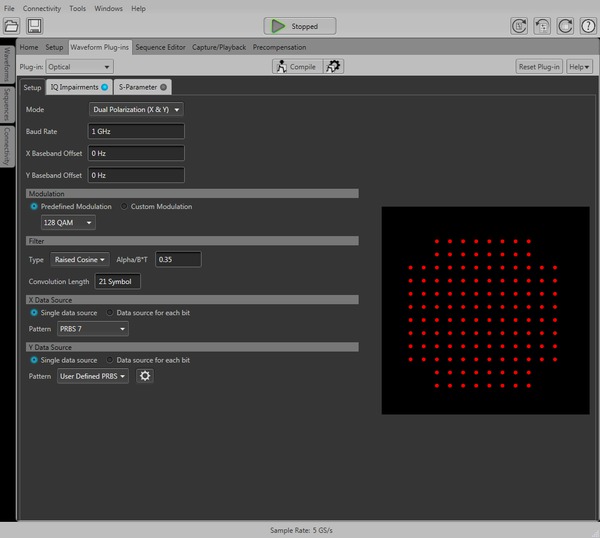
Generic OFDM creation
In today's wireless world, OFDM is becoming the modulation method of choice for transmitting large amounts of digital data over short and medium distances. The need for wide bandwidths and multiple carriers create challenges for engineers who need to create OFDM signals to test their RF receivers. The AWG70000B Series, when coupled with the OFDM plug-in, allows users to configure every part of the OFDM signal definition. Engineers can build signals symbol-by-symbol to create a complete OFDM frame or let the plug-in choose default values for some signal aspects. The combined AWG and OFDM plug-in supports a variety of data coding formats that include Reed Solomon, Convolution, and Scrambling. Users also have the ability to define each subcarrier in the symbol which can be configured independently for type, modulation, and base data. The OFDM plug-in gives visibility into all aspects of the OFDM signal by providing a symbol table that gives a summary of all the carriers in the selected symbol. OFDM packets/ frames can be built by specifying the spacing between the symbols/frames and parts of the OFDM packets can be stressed by adding gated noise.
High-speed serial signal generation
Serial signals are made up entirely of binary data — simple ones and zeros. As clock rates have increased, these simple ones and zeros have begun to look more like analog waveforms because analog events are embedded in the digital data. The zero rise time and the perfect flat tops of textbook digital signals no longer represent reality. Electronic environments have noise, jitter, crosstalk, distributed reactances, power supply variations, and other shortcomings. Each takes its toll on the signal. A real-world digital "square wave" rarely resembles its theoretical counterpart.
Since the AWG70000B Series is an analog waveform source, it is the perfect single-box solution used to create digital data streams and mimic the analog imperfections that occur in real-world environments. The use of direct synthesis techniques allow engineers to create signals that simulate the effects of propagation through a transmission line. Rise times, pulse shapes, delays, and aberrations can all be controlled. When used in conjunction with the High Speed Serial (HSS) plug-in, engineers are provided control over every aspect of their digital signals, reaching speeds of up to 50 Gb/s. This is exactly what is needed for rigorous receiver testing requirements.
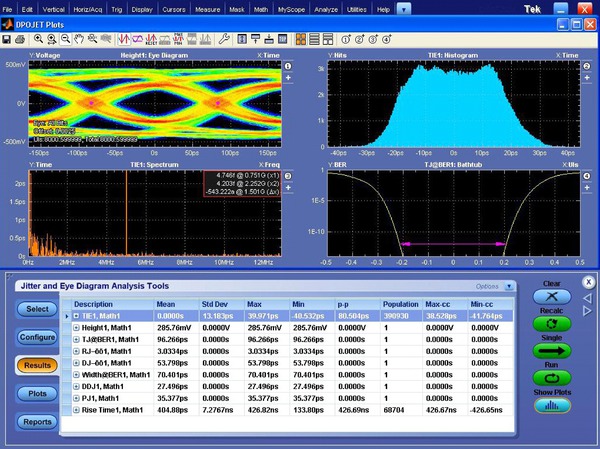
The HSS plug-in allows the AWG70000B Series instruments to create a variety of digital data impairments such as jitter (Random, Periodic, Sinusoidal), noise, pre/de-emphasis, duty cycle distortion, Inter-symbol Interference (ISI), Duty Cycle Distortion (DCD), and Spread Spectrum Clocking (SSC). The transmission environments of both boards and cables can be emulated using S-parameter files that can be applied to any waveform. The AWG70000B and the HSS plug-in also provides base pattern waveforms for many of today's high-speed serial applications such as SATA, Display Port, SAS, PCI-E, USB, and Fibre Channel.
For high-speed serial applications, the AWG70000B Series offers the industry's best solution for addressing challenging signal stimulus issues faced by digital designers who need to verify, characterize, and debug complex digital designs. The file-based architecture uses direct synthesis to create complex data streams and provides users with the simplicity, repeatability, and flexibility required to solve the toughest signal generation challenges in high-speed serial communication applications.
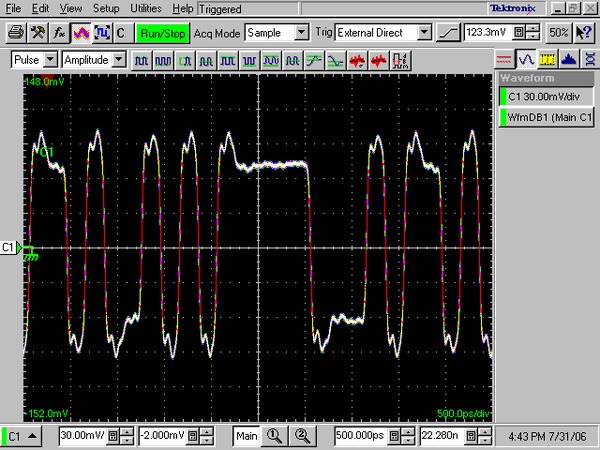
Create correction coefficients
Compensate for imperfections in your test setup introduced by cabling, passive and active RF components and devices to achieve a flat frequency and linear phase response from your AWG. The Precompensation plug-in for current Tektronix AWG instruments and the PC SourceXpress software allows users to compensate for the first and second Nyquist zones of the AWG. Users can define the LO frequency and choose to get correction coefficients for either lower side band or upper side band, as well as define the carrier frequency. In all the modes, users can define the bandwidth of compensation either by specifying start and end frequencies (RF & IF) or bandwidth (in IQ/IQ with modulator).
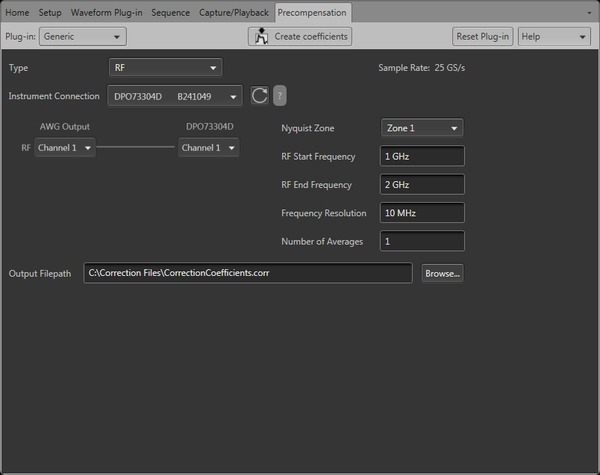
Streaming ID
Managing a dynamic reproduction of an RF test environment can sometimes mean keeping track of thousands of individual waveforms. The new Streaming Waveform ID (Streaming WID) option adds a dedicated ethernet port to the rear panel of the instrument. This port allows for direct access to the sequencer hardware via UDP-formatted packets enabling immediate access to over 16000 sequence steps available in system memory. Replicate the chaos of the real world with unprecedented accuracy and accomplish more in less time with Streaming WIDs.
Option AC
The AWG70001B, with Option AC, provides you with an additional high output amplitude connector. Option AC adds a single-ended AC coupled connector to the front panel of the single channel AWG70001B Arbitrary Waveform Generator. User controls are added to allow switching the output path between the standard Direct output connectors or the AC output connector. When switched to the AC path, additional user controlled amplification and attenuation is added to the signal path.
In AC output mode, you can choose one of the four signal filter paths and set the output amplitude, letting the instrument automatically set the step attenuators in the selected filter path. For greater control, you can manually set the attenuation of the step attenuators for your selected filter path.
- No filter: -70 to +25 dBm at 1 GHz CW calibration frequency
- 11.5 GHz Low Pass: -70 to +25 dBm at 1 GHz CW calibration frequency
- 10 GHz - 14.5 GHz Band Pass: -77 to +18 dBm at 11 GHz CW calibration frequency
- 13 GHz - 18 GHz Band Pass: -90 to +20 dBm at 14 GHz CW calibration frequency
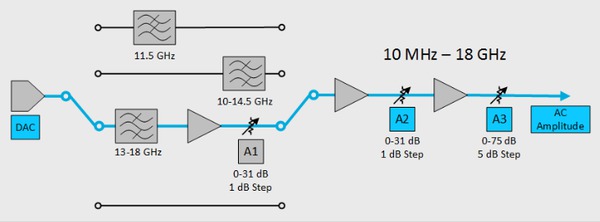
LXI Class C
Using the LXI Web Interface, you can connect to the AWG70000B Series through a standard web browser by simply entering the AWG's IP address in the address bar of the browser. The web interface enables viewing of instrument status and configuration, as well as status and modification of network settings. All web interaction conforms to the LXI Class C specification.
Specifications
All specifications are typical unless noted otherwise. All specifications apply to all models unless noted otherwise.
Model overview
| AWG70001B | AWG70002B | ||
|---|---|---|---|
| Digital to analog converter | |||
| Sample rate | 1.5 kS/s - 50 GS/s | 1.5 kS/s - 25 GS/s | |
| Resolution | 10 bit (no markers selected), 9 bit (one marker selected), or 8 bit (two markers selected) | ||
| Number of channels | 1 | 2 | |
Hardware characteristics
- Run modes
- Continuous
- Waveform is continuously repeated
- Triggered
- Waveform is output only once after a trigger is received
- Triggered Continuous
- Waveform is continuously repeated after a trigger is received
- Waveform memory
- AWG70001B
- Standard: up to 2 GSamples
With extended memory: up to 32 GSamples
- AWG70002B
- Standard: up to 2 GSamples per channel
With extended memory: up to 16 GSamples per channel
- Minimum waveform length
- Triggered run modes
- AWG70001B: 4800 points
AWG70002B: 2400 points
- Continuous run mode
- 1 point
- Waveform granularity
- Continuous run mode
- 1 point
- Triggered run modes
- AWG70001B: 2 points
AWG70002B: 1 point
- Waveform interleaving
- AWG70001B
Non-interleaved when ≤ 25GS/s
Interleaved when > 25GS/s
- AWG70002B
- Non-interleaved at all sample rates
- DAC Resolution
8-bit, 9-bit, or 10-bit
Analog output characteristics
- Number of channels
- AWG70001B
- 1 channel
- AWG70002B
- 2 channels
- Connector type
- Aeroflex/Weinschel Planar Crown Universal Connector System with SMA female adapter
- Output impedance
- 50 Ω
- Effective frequency output
- Fmaximum (specified) is determined as "sample rate / oversampling rate" or "SR / 2.5".
- AWG70001B
- 20 GHz
- AWG70002B
- 10 GHz
- Bandwidth
Measured with a multi-sine waveform with equal amplitude across the band. The Sin(x)/x response is mathematically removed from the measured response before recording the -3 dB crossing.
- AWG70001B
- 15 GHz
- AWG70002B
- 13.5 GHz
- Output amplitude
Amplitude levels are measured between differential outputs (+) to (-). For single-ended output, the amplitude level will be one-half the specified voltage levels.
- Range
- 500 mVp-p to 1 Vp-p
- Resolution
- 1.0 mV
- Accuracy
- ±(2% of amplitude + 1 mV)
- Rise/fall time
Rise/fall time measured at 20% to 80% levels, related by a factor of 0.75 to the industry standard of 10% to 90% levels.
- AWG70001B
Sampling rate ≤ 25 GS/s: < 23 ps
Sampling rate at 50 GS/s: < 27 ps
- AWG70002B
- < 22 ps
- Serial data bit rate
Bit rate determined as "sample rate / 4 points per cycle", allowing full impairment generation.
- AWG70001B
12.5 Gb/s
- AWG70002B
- 6.25 Gb/s
- Output flatness
- AWG70001B
- ±1.8 dB up to 10 GHz,
+1.8 dB to -3 dB from 10 GHz to 15 GHz
- AWG70002B
- +0.8 dB to -1.5 dB up to 10 GHz
- Output match, SWR
- AWG70001B
- DC to 5 GHz = 1.32:1
5 GHz to 10 GHz = 1.52:1
10 GHz to 20 GHz = 1.73:1
- AWG70002B
- DC to 10 GHz = 1.61:1
- Frequency response
- AWG70001B
AWG70001B frequency response at 50 GS/s with Sin(x)/x response mathematically removed from measured data.

AWG70001B measured frequency response and ideal Sin(x)/x response at 50 GS/s.

- AWG70002B
AWG70002B frequency response at 25 GS/s with Sin(x)/x response mathematically removed from measured data.

AWG70002B measured frequency response and ideal Sin(x)/x response at 25 GS/s.

Waveform characteristics
- Waveform file import capability
- Import waveform format by series:
- .AWGX file created by Tektronix AWG5200/70000 Series
- .AWG file created by Tektronix AWG5000 or AWG7000 Series
- .PAT and *.WFM file formats created by Tektronix AWG400/500/600/700 Series
- .IQT file format created by Tektronix RSA3000 Series
- .TIQ file format created by Tektronix RSA6000/5000 Series or MDO4000 Series
- .WFM or *.ISF file formats created by Tektronix TDS/DPO/MSO/DSA Series
- .TXT file format
- .MAT Matlab file format
- .SEQX file format created by Tektronix AWG5200/70000 Series
- .SEQ file format created by the Tektronix AWG400/500/600/700 Series
- .TMP or .PRM file formats; Midas Blue (Data Type 1000/1001; Scalar and complex data; 8-,16-, 32-, and 64-bit integer and 32- and 64-bit float data format types)
- Waveform file export capability
- .WFMX file format, AWG5200/70000 series native format
- .WFM file format, AWG400/500/600/700 waveform file
- .TIQ file format, RSA6000/5000 IQ Pair
- .TXT file format
Trigger input characteristics
- Number
- 2 (A and B)
- Connector
- SMA (rear panel)
- Polarity
- Positive or negative selectable
- Impedance
- 50 Ω, 1 kΩ
- Range
- 50 Ω
- <5 V
- 1 kΩ
- ±10 V
- Threshold
- Range
- -5.0 V to 5.0 V
- Resolution
- 0.1 V
- Accuracy
- ±5% of the setting + 0.1 V
- Trigger to output delay
- Asynchronous
- 8625/(fclk + 20 ns) ±20 ns (710 ns @ fclk = 12.5 GHz, 25 GSps)
- Synchronous
- 8120/(fclk + 20 ns) ±20 ns (670 ns @ fclk = 12.5 GHz, 25 GSps)
- where fclk is the frequency of the DAC sampling clock
- Trigger minimum pulse width
- 20 ns
- Trigger hold-off
- 8320/fclk ±20 ns
where fclk is the frequency of the DAC sampling clock
Sequencer
The sequencer is a firmware upgrade that allows the user to run a sequence of waveforms. The sequencer runs independent channels except for the clock.
- Maximum repeat count
- 220 counts (1,048,576 counts)
- Maximum sequencing steps
- 16,383
- Subsequencing
- Single level depth
- Waveform granularity resolution
- AWG70001B
2
- AWG70002B
1
- Minimum waveform length
- AWG70001B
4800 points
- AWG70002B
2400 points
Spurious Free Dynamic Range (SFDR)
- Spurious free dynamic range (SFDR) characteristics
- Frequency output of AWG 1 2
- AWG70001B operating at 50 GS/s
In band performance Adjacent band performance Analog channel output frequency
Measured across Specification Measured across Specification 100 MHz DC - 1 GHz -80 dBc DC - 10 GHz -72 dBc DC - 500 MHz DC - 500 MHz -70 dBc DC - 1.5 GHz -66 dBc DC - 1 GHz DC - 1 GHz -63 dBc DC - 3 GHz -63 dBc DC - 2 GHz DC - 2 GHz -62 dBc DC - 6 GHz -60 dBc DC - 3 GHz DC - 3 GHz -60 dBc DC - 6 GHz -52 dBc DC - 5 GHz DC - 5 GHz -52 dBc DC - 6 GHz -52 dBc 5 GHz - 6 GHz 5 GHz - 6 GHz -52 dBc 3 GHz - 9 GHz -40 dBc 6 GHz - 7 GHz 6 GHz - 7 GHz -42 dBc 4 GHz - 10 GHz -42 dBc 7 GHz - 8 GHz 7 GHz - 8 GHz -60 dBc 6 GHz - 12.5 GHz -52 dBc 8 GHz - 10 GHz 8 GHz - 10 GHz -50 dBc 6 GHz - 12.5 GHz -52 dBc 10 GHz - 12 GHz 10 GHz - 12 GHz -53 dBc 6 GHz - 12.5 GHz -50 dBc 12 GHz - 13 GHz 12 GHz - 13 GHz -22 dBc 10 GHz - 15 GHz -22 dBc 13 GHz - 14 GHz 13 GHz - 14 GHz -54 dBc 11 GHz - 16 GHz -20 dBc 14 GHz - 16 GHz 14 GHz - 16 GHz -46 dBc 13 GHz - 18 GHz -38 dBc 16 GHz - 18.5 GHz 16 GHz - 18.5 GHz -42 dBc 14 GHz - 20 GHz -30 dBc 18.5 GHz - 20 GHz 18.5 GHz - 20 GHz -28 dBc 16 GHz - 20 GHz -24 dBc - AWG70001B and AWG70002B operating at 25 GS/s
In band performance Adjacent band performance Analog channel output frequency
Measured across Specification Measured across Specification 100 MHz DC - 1 GHz -80 dBc DC - 10 GHz -72 dBc 0 - 500 MHz DC - 500 MHz -70 dBc DC - 1.5 GHz -66 dBc DC - 1 GHz DC - 1 GHz -63 dBc DC - 3 GHz -63 dBc DC - 2 GHz DC - 2 GHz -62 dBc DC - 6 GHz -60 dBc DC - 3 GHz DC - 3 GHz -60 dBc DC - 6 GHz -52 dBc DC - 5 GHz DC - 5 GHz -52 dBc DC - 6 GHz -52 dBc 5 GHz - 6 GHz 5 GHz - 6 GHz -52 dBc 3 GHz - 9 GHz -40 dBc 6 GHz - 7 GHz 6 GHz - 7 GHz -42 dBc 4 GHz - 10 GHz -42 dBc 7 GHz - 8 GHz 7 GHz - 8 GHz -55 dBc 6 GHz - 12.5 GHz -50 dBc 8 GHz - 10 GHz 8 GHz - 10 GHz -50 dBc 6 GHz - 12.5 GHz -50 dBc
Output distortions
- Harmonic distortion
- Sample rate = 25 GS/s
- 2nd harmonic, at output frequency
Frequency range Value < 2 GHz < -60 dBc 2 GHz - 6 GHz < -50 dBc > 6 GHz < -42 dBc - 3rd harmonic, at output frequency
Frequency range Value < 1 GHz < -60 dBc 1 GHz - 2 GHz < -50 dBc > 2 GHz < -40 dBc
- Effective number of bits (ENOB)
- AWG70001B
- 4.6 bits at 14.99 GHz
All noise and distortion DC - 20 GHz
- AWG70002B
- 5.6 bits at 9.99 GHz
All noise and distortion DC - 12.5 GHz
- Phase noise
- Phase noise in reduced jitter mode.

- Jitter
- Random jitter
- 250 fs RMS
- Total jitter
- 10 ps p-p at 12.5 Gb/s
Channel timing characteristics
- These specifications apply to the AWG70002B only.
- Channel to channel skew
- ±5 ps
- Output skew control
- Range
- -100 ps to 100 ps
- Resolution
- 500 fs
- Accuracy
- ±5 ps
- Intra-channel skew
- <5 ps
References
- Reference In
- Connector
- SMA (rear panel)
- Impedance
- 50 Ω, AC coupled
- Input amplitude
- –5 dBm to +5 dBm
- Fixed frequency range
- 10 MHz, ±40 Hz
- Variable frequency range
- 35 MHz to 250 MHz
- 10MHz Reference Out
- Connector
- SMA (rear panel)
- Impedance
- 50 Ω, AC coupled
- Amplitude
- +4 dBm ±2 dBm
- Frequency (guaranteed)
- 10 MHz ±(1 ppm + aging)
Clock characteristics
- Clock In
- Connector
- SMA (rear panel)
- Input impedance
- 50 Ω, AC coupled
- Frequency range
- 6.25 GHz to 12.5 GHz
- Input amplitude
- 0 dBm to +10 dBm
- Clock Out
- Connector
- SMA (rear-panel)
- Output impedance
- 50 Ω AC coupled
- Output amplitude
- +5 dBm to +10 dBm
- Sync Clock Out
- Connector
- SMA (rear panel)
- Output impedance
- 50 Ω, AC coupled
- Frequency
- 1/80 of the clock output
- Amplitude
- 1.0 V ±150 mV p-p into 50 Ω
Marker characteristics
- Number
- AWG70001B
- Total of 2
- AWG70002B
- Total of 4 (2 per channel)
- Style
- Differential
- Connector
- SMA (front panel)
- Impedance
- 50 Ω
- Level into 50 Ω
Characteristic Value Window -1.4 V to 1.4 V Amplitude 0.5 V p-p to 1.4 V p-p Resolution 10 mV Accuracy ±(10% of setting + 50 mV) into 50 Ω Rise/fall time (20% - 80%) <35 ps (High: 1.0 V, Low: 0 V)
- Timing skew
Characteristic Value Intra-channel <12 ps (between each channel (+) Pos and (-) Neg output) Inter-channel <15 ps (between Marker 1 and Marker 2 outputs)
- Delay control
Characteristic Value Delay from analog output AWG70001B: 205 ps ±20 ps
AWG70002B: 767 ps ±20 ps
AWG70001B (Option AC): -353 ps ±20 ps
Range 0 to 100 ps Resolution 1 ps Accuracy ±15 ps typical
- Jitter
Characteristic Value Random RMS 0.4 ps RMS Total p-p 20 ps p-p (Using PRBS15 pattern)
Auxiliary Outputs
- Auxiliary Outputs can be configured as sequencer flags or timers.
- Connector
- SMB (rear panel)
- Number of outputs
- AWG70001B
- 4
- AWG70002B
- 8
- Impedance
- 50 Ω
- Amplitude
- High
- 3.3 V into 50 Ω
- Low
- 0 V
- Period
- When configured as a timer.
1 Hz (1 s) to 100 kHz (10 μs)
Pattern jump
- Pin assignments
Pin Pin Pin 1 GND 6 GND 11 Data bit 5, input 2 Data bit 0, input 7 Strobe, input 12 Data bit 6, input 3 Data bit 1, input 8 GND 13 Data bit 7, input 4 Data bit 2, input 9 GND 14 GND 5 Data bit 3, input 10 Data bit 4, input 15 GND - Input impedance
- 1 kΩ pull-down to GND
- Input levels
- 3.3 V LVCMOS
5 V TTL compliant
- Number of destinations
- 256
- Strobe polarity
- Negative edge
- Strobe Minimum Pulse Width
- 64 ns
- Strobe Setup and Hold
- Setup
- 5 ns
- Hold
- 5 ns
AWG70001B Option AC output characteristics
These characteristics apply to the optional AC output connector available with the AWG70001B models.
- Connector
- Aeroflex/Weinschel Planar Crown Universal Connector System with SMA female adapter
- Number of analog AC outputs
- 1
- Type of outputs
- single ended
- Output impedance
- 50 Ω
- Frequency range
Filter Value No filter 10 MHz to 18 GHz Low pass 10 MHz to 11.5 GHz Band pass (10 to 14.5 GHz) 10 GHz to 14.5 GHz Band pass (13 to 18 GHz) 14 GHz to 18 GHz - Amplitude
- Range (for a CW signal at specified frequencies in each path)
Filter Value No filter 25 dBm to -70 dBm at 1 GHz
18 dBm to -77 dBm at 13 GHz
Low pass 25 dBm to -70 dBm at 1 GHz Band pass (10 to 14.5 GHz) 18 dBm to -77 dBm at 11 GHz Band pass (13 to 18 GHz) 20 dBm to -90 dBm at 14 GHz
18 dBm to -90 dBm at 18 GHz
- Accuracy (at calibration frequency)
Filter Value No filter ±0.5 dB at 1 GHz, ambient 16 °C to 26 °C
±1.5 dB at 1 GHz, ambient 0 °C to 50 °C
Low pass ±0.5 dB at 1 GHz, ambient 16 °C to 26 °C
±1.5 dB at 1 GHz, ambient 0 °C to 50 °C
Band pass (10 to 14.5 GHz) ±1.5 dB at 11 GHz, ambient 16 °C to 26 °C
±3.0 dB at 11 GHz, ambient 0 °C to 50 °C
Band pass (13 to 18 GHz) ±1.5 dB at 14 GHz, ambient 16 °C to 26 °C
±3.5 dB at 14 GHz, ambient 0 °C to 50 °C
- Resolution
- 0.01 dB
- Amplitude flatness
Specifications include the sin(x)/x roll off of the DAC at 50 GS/s.
Filter Value No filter ± 3 dB, 10 MHz to 10 GHz
± 4 dB, 10 MH to 13 GHz
Low pass ± 3 dB, 10 MHz to 10 GHz Band pass (10 to 14.5 GHz) ± 3.5 dB, 10 GHz to 14.5 GHz Band pass (13 to 18 GHz) ± 4.5 dB from 13 GHz to 18 GHz - Harmonic distortion
- Operating at 50 GS/s.
- 2nd Harmonic at output frequency
Frequency range Value < 1 GHz < -34 dBc 1 GHz - 4 GHz < -30 dBc > 4 GHz < -28 dBc - 3rdHarmonic at output frequency
Frequency range Value < 1 GHz < -50 dBc 1 GHz - 4 GHz < -45 dBc > 4 GHz < -33 dBc
- Amplifier 1 dB compression
- Operating at 50 GS/s
Filter Frequency Value No filter 1 GHz > 25 dBm 13 GHz > 22 dBm Low pass 1 GHz > 25 dBm Band pass (10 to 14.5 GHz) 11 GHz > 22 dBm Band pass (13 to 18 GHz) 14 GHz > 22 dBm 18 GHz > 20 dBm
- Switching time
- The time required for the attenuators and amplifiers to settle to the specified output amplitude after an amplitude change.
20 ms
Power source
- AC line input
- 100 to 240 V AC, 50/60 Hz
- Consumption
- 500 Watts
Computer system
- Operating system / peripherals / IO
Microsoft Windows 10 OS
16 GB
≥ 1 TB solid state drive
6 USB ports (2 front - USB 2.0 ) (4 rear - USB 3.0)
RJ-45 Ethernet connector (rear panel) supports 10/100/1000BASE-T
VGA video (rear panel) for external monitor
eSATA (rear panel)
- Display characteristics
- LED backlit touch screen display, 132 x 99 mm (165 mm diagonal), 1024 × 768 pixels
- Software driver for third-part applications
- IVI-COM driver
IVI-C driver
- Instrument control / data transfer
- GPIB through USB B device port (requires external adapter TEK-USB-488)
- Remote control and data transfer (conforms to IEEE-Std 488.1, compatible with IEEE-Std 488.2 and SCPI-1999.0)
- Ethernet
- Remote control and data transfer (conforms to IEEE-Std 802.3)
- LAN eXtensions for Instrumentation (LXI)
- Class LXI Class C Version 1.4
Physical characteristics
- Dimensions
- Height
- 153.6 mm (6.05 in)
- Width
- 460.5 mm (18.13 in)
- Depth
- 603 mm (23.76 in)
- Weight
- Net weight without packaging
37.0 lb (16.8 kg)
38.56 lb (17.49 kg) (AWG70001B with option AC)
- Net weight with packaging
49.4 lb (22.4 kg)
50.96 lb (23.12 kg) (AWG70001B with option AC)
- Cooling clearance
- Top
- 0 in
- Bottom
- 0 in
- Left side
- 50 mm (2 in)
- Right side
- 50 mm (2 in)
- Rear
- 0 in
EMC, environment, and safety
- Temperature
- Operating
- 0 ºC to +50 ºC (+32 ºF to +122 ºF)
- Non-operating
- -20 ºC to +60 ºC (-4 ºF to +140 ºF)
- Humidity
- Operating
5% to 90% relative humidity (% RH) at up to 30 °C
5% to 45% relative humidity above 30 °C up to 50 °C
Non-condensing
- Non-operating
5% to 90% relative humidity (% RH) at up to 30 °C
5% to 45% relative humidity above 30 °C up to 60 °C
Non-condensing
- Altitude
- Operating
Up to 3,000 meters (9,843 feet)
Derate maximum operating temperature by 1 °C per 300 meters above 1500 meters.
- Non-operating
- Up to 12,000 meters (39,370 feet)
- Vibration
- Operating
Sine: 0.33 mm p-p (0.013 in p-p) constant displacement, 5 to 55 Hz
Random: 0.27 GRMS from 5 to 500 Hz, 10 minutes per axis
- Nonoperating
- Random: 2.28 GRMS from 5 to 500 Hz, 10 minutes per axis
- Mechanical shock
- Operating
- Half-sine mechanical shocks, 30 g peak, 11 ms duration, 3 drops in each direction of each axis
- Regulatory
- Safety
- UL61010-1, CAN/CSA-22.2, No.61010-1, EN61010-1, IEC61010-1
- Emissions
- EN55011 (Class A), IEC61000-3-2, IEC61000-3-3
- Immunity
- IEC61326, IEC61000-4-2/3/4/5/6/8/11
- Regional certifications
Europe Australia/New Zealand EN61326 AS/NZS 2064
Ordering information
Models
| AWG70001B | Arbitrary Waveform Generator: 1-Channel, 10-bit, up to 50 Gs/s |
| AWG70001B AC3 | Amplifier and attenuator option for AWG 70000 series |
| AWG70001B BASIC3 | Standard attenuation for AWG 70000 series |
| AWG70000-150 | Mandatory License; 50 Gs/s Sample Rate for AWG70001B; Node Locked |
| AWG70001B SEQ | Add Sequencing to the AWG70001B; requires export control license |
| AWG70001B STRID | Add Streaming ID to the AWG70001B; requires SEQ and export control license |
| AWG70000-MEM | License; Increase memory to 32GS (on AWG70001B) or 16GS per channel (on AWG70002B); Node Locked |
| AWG70002B | Arbitrary Waveform Generator: 2-Channel, 10-bit, up to 25 Gs/s |
| AWG70002B BASIC | Mandatory. Base configuration for the AWG 70002B |
| AWG70000-2083 | License; 8 Gs/s sample rate for the AWG 70002B; Node Locked |
| AWG70000-2163 | License; 16 Gs/s sample rate for the AWG 70002B; Node Locked |
| AWG70000-2253 | License; 25 Gs/s sample rate for the AWG 70002B; Node Locked |
| AWG70002B SEQ | Add Sequencing to the AWG70002B; requires export control license |
| AWG70002B STRID | Add Streaming ID to the AWG70002B; requires SEQ and export control license |
| AWG70000-MEM | License; Increase memory to 32GS (on AWG70001B) or 16GS per channel (on AWG70002B); Node Locked |
Instrument options
Power plug options
- Opt. A0
- North America power plug (115 V, 60 Hz)
- Opt. A1
- Universal Euro power plug (220 V, 50 Hz)
- Opt. A2
- United Kingdom power plug (240 V, 50 Hz)
- Opt. A3
- Australia power plug (240 V, 50 Hz)
- Opt. A4
- North America power plug (240 V, 50 Hz)
- Opt. A5
- Switzerland power plug (220 V, 50 Hz)
- Opt. A6
- Japan power plug (100 V, 50/60 Hz)
- Opt. A10
- China power plug (50 Hz)
- Opt. A11
- India power plug (50 Hz)
- Opt. A12
- Brazil power plug (60 Hz)
- Opt. A99
- No power cord
Language options
- Opt. L0
- English manual
- Opt. L5
- Japanese manual
- Opt. L7
- Simplified Chinese manual
- Opt. L8
- Traditional Chinese manual
- Opt. L10
- Russian manual
- Opt. L99
- No manual
Service options
- Opt. C3
- Calibration Service 3 Years
- Opt. C5
- Calibration Service 5 Years
- Opt. D1
- Calibration Data Report
- Opt. D3
- Calibration Data Report 3 Years (with Opt. C3)
- Opt. D5
- Calibration Data Report 5 Years (with Opt. C5)
- Opt. G3
- Complete Care 3 Years (includes loaner, scheduled calibration, and more)
- Opt. G5
- Complete Care 5 Years (includes loaner, scheduled calibration, and more)
- Opt. R3
- Repair Service 3 Years (including warranty)
- Opt. R5
- Repair Service 5 Years (including warranty)
Standard accessories
- 131-8689-xx
Analog output Planar Crown 7005A-1 SMA female adapters (preinstalled)
AWG70001B: two (three with Option AC)
AWG70002B: four
- 015-1022-xx
- One 50 Ω SMA terminator per channel
- —
- Installation and safety manual (Specify language option at time of order.)
- —
- Certificate of calibration
- —
- Power cord (Specify power cord option at time of order.)
Recommended accessories
| Item | Description | Part number |
|---|---|---|
| Synchronization Hub | Enables fast synchronization of multiple AWG70000 series instruments | AWGSYNC01 Synchronization Hub |
| GPIB to USB Adapter | Enables GPIB control through USB B port | TEK-USB-488 |
| Rack mount kit | Rack mount kit for AWG70000 Series | AWGRACK |
| MDC4500-4B | DC amplifier for MIPI applications | MDC4500-4B |
| Baluns | 300 kHz - 26.5 GHz | Marki BAL-0026 |
| 5 MHz - 20 GHz | Hyperlabs HL9402 | |
| Bias Ts | 200 kHz - 12 GHz | Mini-Circuits ZX85-12G-S+ |
| Power Splitters | 1.5 kHz - 18 GHz | Mini-Circuits ZX10-2-183-S+ |
| DC-18 GHz | Aeroflex/Weinschel 1515 | |
| Amplifiers | 0.01 - 20 GHz, 30 dB gain | RF-Lambda RAMP00G20GA |
| Adapter | SMB female to SMA female | Mouser 565-72979 |
| Programmer manual | Programming commands, English only | 077-1452-xx (Visit the Tektronix website) |
| Hard transit case and foam | - | 016206100 |
| Pelican case | - | 016-2127-00 |
Product upgrades
The following instrument upgrades are available post sales.
See the Plug-ins section for a list of software waveform plug-ins available post sales.
- AWG70001B
- AWG701BUP AC
- Adds a single-ended AC coupled output connector with additional amplification and attenuation (factory upgrade only)
- AWG701BUP SSD
- Replacement / additional Solid State Disc Drive
- AWG70000-MEM
- Increases waveform record length to 32 G
- AWG70000-MEM
- Increases waveform record length to 32 G
- AWG701BUP SEQ
- Adds Sequencing
- AWG701BUP STRID
- Adds Streaming ID
- AWG70002B
- AWG70000-MEM
- Increases waveform record length to 16 G per channel
- AWG70000-0816
- License; Upgrade from 8 Gs/s to 16 GS/s sample rate for the AWG 70002B; Node Locked
- AWG70000-0825
- License; Upgrade from 8 Gs/s to 25 GS/s sample rate for the AWG 70002B; Node Locked
- AWG70000-1625
- License; Upgrade from 16 Gs/s to 25 GS/s sample rate for the AWG 70002B; Node Locked
- AWG702BUP SSD
- Replacement / additional Solid State Disc Drive
- AWG702BUP SEQ
- Adds Sequencing
- AWG702BU*P* SEQ
- Adds Sequencing
- AWG702BU*P* SEQ
- Adds Streaming ID
- AWG702BUP STRID
- Adds Streaming ID
Plug-ins
Plug-ins increase the capabilities of the arbitrary waveform generators. Various plug-ins are available providing unique types of waveforms or additional compensation. Each plug-in has its own installation file which installs seamlessly into the generators. After installation, it simply becomes a new menu selection. No other configuration is necessary.
| Plug-in | Description | Nomenclature | Licensed enhancements |
|---|---|---|---|
| Multitone & Chirp plug-in | Create chirps, notches, and tones | MTONENL-SS01 MTONEFL-SS01 | |
| PreCompensation plug-in | Create correction coefficients that can be applied on waveforms to get flat frequency and linear phase response | PRECOMNL-SS01 PRECOMFL-SS01 | |
| High Speed Serial plug-in | Create pre-distorted waveforms to test a device's conformance to standards | HSSNL-SS01 HSSFL-SS01 | S-Parameters and Intersymbol Interference unlocked with S-Parameters plug-in license |
| RF Generic plug-in | Create digitally modulated signals with multiple carrier groups | RFGENNL-SS01 RFGENFL-SS01 | S-Parameters unlocked with S-Parameters plug-in license |
| Optical plug-in | Create waveforms with complex modulation schemes for optical testing | OPTICALNL-SS01 OPTICALFL-SS01 | S-Parameters unlocked with S-Parameters plug-in license Spread Spectrum Clocking unlocked with Spread Spectrum Clocking plug-in license |
| OFDM plug-in | Create Single or Multiple OFDM based Frames with one or more bursts | OFDMNL-SS01 OFDMFL-SS01 | S-Parameters unlocked with S-Parameters plug-in license |
| RADAR plug-in | Create RADAR pulsed waveforms with various modulations and impairments | RADARNL-SS01 RADARFL-SS01 | S-Parameters unlocked with S-Parameters plug-in license |
| Environment plug-in | Create real world scenarios for commercial, electronic warfare, and simulations for monitoring and receiver testing | ENVNL-SS01 ENVFL-SS01 | |
| Spread Spectrum Clocking plug-in | Adds SSC capability to the High Speed Serial and Optical plug-ins | SSCFLNL-SS01 SSCFLFL-SS01 | |
| S-Parameters plug-in | Adds S-Parameter capability to the RF Generic, High Speed Serial, Optical, OFDM, and RADAR plug-ins | SPARANL-SS01 SPARAFL-SS01 | |
| Pattern Generator, Pulse, & LVDS Video Signal Generator plug-ins | Free web download |
Plug-ins require the purchase of a license before they are fully functional.
There are two types of licenses available for each plug-in: node-locked (NL) and floating (FL).
Node Locked Licenses (NL) provide your own copy of the application on your instrument and are permanently assigned to a product model/serial number.
Floating Licenses (FL) can be moved between product models.









